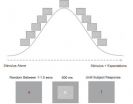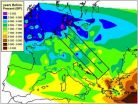(Press-News.org) The human brain works incredibly fast. However, visual impressions are so complex that their processing takes several hundred milliseconds before they enter our consciousness. Scientists at the Max Planck Institute for Brain Research in Frankfurt am Main have now shown that this delay may vary in length. When the brain possesses some prior information − that is, when it already knows what it is about to see − conscious recognition occurs faster. Until now, neuroscientists assumed that the processes leading up to conscious perception were rather rigid and that their timing did not vary. (Journal of Neuroscience, January 26 2011)
On their way from the eye, visual stimuli are analysed in manifold ways by different processing stages in the brain. It is not until they have passed several processing steps that the stimuli reach conscious perception. This unconscious processing prior to perception usually takes approximately 300 milliseconds. The Max Planck scientists were now able to demonstrate that the timing of this process, far from being rigid, is in fact variable. In an experiment, participants perceived stimuli more efficiently and faster if they knew what to expect.
To investigate this, the scientists showed the participants images with a background of randomly distributed dots on a monitor. During an image sequence, the distribution of the dots systematically changed such that a symbol gradually appeared. Following each image, the participants indicated if they could see the symbol by pressing a button. As soon as the symbol had appeared fully and was clearly recognisable, the scientists presented the same image sequence in reverse order, such that the symbol gradually faded again. During the entire experiment, electroencephalographic (EEG) activity of the participants was measured.
Whereas the participants took relatively long to recognise the symbol in the first sequence of images with increasing visibility, the threshold of awareness in the second, reverse presentation of images was much lower. The participants were able to recognise the letters even at very poor resolution. "Expectations based on previously acquired information apparently help to perceive the object consciously", says Lucia Melloni, first author of the study. Once the participants knew which symbol was hiding in the random field of noise, they were able to perceive it better. The scientists have thus confirmed previous studies, according to which people perceive moving objects better if they already know in which direction the objects will move.
Moreover, the measurements of EEG activity produced astonishing results. "We found that the timing of EEG activity for conscious perception changed depending on the person's expectations", says Lucia Melloni. If the participants could predict what they were going to see, the characteristic EEG pattern for conscious perception took place 100 milliseconds earlier than without prior expectations.
The scientists might thus have found a conclusive explanation for the contradictory results of other neuroscientific research groups. Depending on the study, they had sometimes found very early and sometimes very late EEG activity correlating with conscious perception. "Our research explains this variability in timing. Apparently, the brain does not process the stimuli rigidly and at the same speed; rather, it is flexible", explains Wolf Singer. Processing is thus faster if the brain only has to compare the incoming visual information with a previously established expectation. As a result, conscious perception occurs earlier. In contrast, if the brain has to assess a stimulus from scratch due to a lack of prior information, the processing takes longer.
These results may show that previous EEG studies have been interpreted incorrectly. "Since the interpretation depends heavily on the sequence of events, EEG activity may have been incorrectly allocated to consciousness processes", surmises Wolf Singer, the Director of the Department for Neurophysiology at the Max Planck Institute for Brain Research in Frankfurt. "In light of these results, it appears necessary to reinvestigate the neuronal correlates of consciousness."
INFORMATION:
Original publication:
Lucia Melloni, Caspar M. Schwiedrzik, Notger Müller, Eugenio Rodriguez, Wolf Singer
Expectations change the signatures and timing of electrophysiological correlates of perceptual awareness
Journal of Neuroscience, January 26, 2011, 31(4):1386-1396
Expectations speed up conscious perception
2011-02-04
ELSE PRESS RELEASES FROM THIS DATE:
Northern hunters slowed down advance of Neolithic farmers
2011-02-04
One of the most significant socioeconomic changes in the history of humanity took place around 10,000 years ago, when the Near East went from an economy based on hunting and gathering (Mesolithic) to another kind on agriculture (Neolithic). Farmers rapidly entered the Balkan Peninsula and then advanced gradually throughout the rest of Europe.
Various theories have been proposed over recent years to explain this process, and now physicists from the University of Girona (UdG) have for the first time presented a new model to explain how the Neolithic front slowed down as ...
Adapting technology to elderly people
2011-02-04
Massive Art Multimedia in Austria and CoSi Elektronik in Germany have a history of collaboration on successful technical projects. A brainstorming session between their developers produced the idea of bringing together many aspects of the modern computing world and applying them specifically to the one group in society that is least likely to already feel those benefits - senior citizens. As with so many projects of this nature, the funding for development was out of reach of two SMEs. By facilitating the funding process EUREKA permitted the development of the project now ...
Death in the bat caves: Disease wiping out hibernating bats
2011-02-04
Conservationists across the United States are racing to discover a solution to White-Nose Syndrome, a disease that is threatening to wipe out bat species across North America. A review published in Conservation Biology reveals that although WNS has already killed one million bats, there are critical knowledge gaps preventing researchers from combating the disease.
WNS is a fatal disease that targets hibernating bats and is believed to be caused by a newly discovered cold-adapted fungus, Geomyces destructans, which infects and invades the living skin of hibernating bats. ...
Using a generic blood pressure and heart drug could save the UK $324 million in 2011
2011-02-04
Using a generic drug to treat hypertension and heart failure, instead of branded medicines from the same class, could save the UK National Health Service (NHS) at least £200 million in 2011 without any real reduction in clinical benefits.
That is the key finding of a systematic review, statistical meta-analysis and cost-effectiveness analysis just published online by IJCP, the International Journal of Clinical Practice.
Researchers from University College London Hospitals NHS Foundation Trust looked at 14 hypertension and heart studies published between 1998 and 2009 ...
Lund adopts chromosome 19
2011-02-04
The genes that make up the human genome were mapped by HUGO, the Human Genome Organisation, and published in 2001. Now the project is expanding into the HUPO, the Human Proteome Organisation. Within the framework of this organisation, many hundreds of researchers around the world will work together to identify the proteins that the different genes give rise to in the human body.
"The 'proteome', the set of all human proteins, is significantly more complicated than the genome. There are over 20 000 proteins coded by the genome in the human body and each protein can have ...
Current use of biodiesel no more harmful than regular diesel
2011-02-04
Up to seven per cent biodiesel blended in regular diesel will presumably not cause greater health risks for the population than the use of pure fossil diesel. This is the main conclusion in a memorandum from the Norwegian Institute of Public Health and the Climate and Pollution Control Agency (formerly SFT) to the Ministry of Health and Care Services and the Ministry of the Environment in Norway.
"A higher content of biodiesel (up to 20 per cent) requires more research to assess health effects. This must include different types of biofuels and blending ratios, as well ...
Blood-clotting agent can diagnose fatal genetic diseases, finds study
2011-02-04
University of Manchester scientists have shown that a protein involved in blood clotting can be used to diagnose and subsequently monitor the treatment of a group of childhood genetic diseases.
In the study, published in the Journal of Inherited Metabolic Disease, the researchers were able to show that the clotting agent, heparan cofactor II/Thrombin (HCII/T) complex, could be used as a 'biomarker', or biological tell, in individuals with mucopolysaccharide (MPS) diseases.
MPS diseases are severe metabolic conditions caused by a genetic defect that affects the body's ...
Drug-abusers have difficulty to recognize negative emotions as wrath, fear and sadness
2011-02-04
University of Granada scientists have been the first to analyze the relation between drug abuse and recognition of basic emotions (happiness, surprise, wrath, fear, sadness and disgust) by drug-abusers. Thus, the study revealed that drug-abusers have difficulty to identify negative emotions by their facial expression: wrath, disgust, fear and sadness.
Further, regular abuse of alcohol, cannabis and cocaine usually affects abusers' fluency and decision-making. Consuming cannabis and cocaine negatively affects work memory and reasoning. Similarly, cocaine abuse is associated ...
Advancing biocrop alternatives in the Pacific Northwest
2011-02-04
Pacific Northwest farmers could someday be filling up their machinery's tanks with fuels produced from their own fields, according to ongoing research by U.S. Department of Agriculture (USDA) scientists.
Since 2003, Agricultural Research Service (ARS) microbiologist Hal Collins and agronomist Rick Boydston have been studying safflower, camelina, soybeans, mustard, canola, wheat, corn and switchgrass to assess their potential for bioenergy production. ARS is USDA's chief intramural scientific research agency, and this research supports the USDA priority of developing ...
Younger immigrants adjust to a new culture faster than do older immigrants
2011-02-04
Moving to a new country is difficult—learning the cultural rules and meanings of your new home is especially challenging. A new study published in Psychological Science, a journal of the Association for Psychological Science, finds that this process is easier for children, but quickly becomes more difficult after about the age of 15.
Psychological scientists have found that many aspects of learning and development have a critical window—if a developmental event doesn't happen by a particular age, it never will. For example, learning perfect pitch or learning to see with ...

